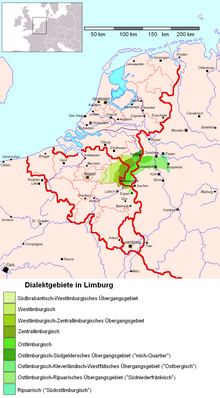The High German languages, or simply High German – not to be confused with Standard High German which is commonly also called "High German" – comprise the varieties of German spoken south of the Benrath and Uerdingen isoglosses in central and southern Germany, Austria, Liechtenstein, Switzerland, Luxembourg, and eastern Belgium, as well as in neighbouring portions of France, Italy, the Czech Republic (Bohemia), and Poland. They are also spoken in diasporas in Romania, Russia, Canada, the United States, Brazil, Argentina, Mexico, Chile, and Namibia.

In historical and comparative linguistics, Low Franconian is a linguistic category used to classify a number of historical and contemporary West Germanic varieties closely related to, and including, the Dutch language. Most dialects and languages included within this category are spoken in the Netherlands, northern Belgium (Flanders), in the Nord department of France, in western Germany, as well as in Suriname, South Africa and Namibia.

The Bergisches Land is a low mountain range in the state of North Rhine-Westphalia, Germany, east of the Rhine and south of the Ruhr. The landscape is shaped by forests, meadows, rivers and creeks and contains over twenty artificial lakes. Wuppertal is the biggest town, while the southern part has economic and socio-cultural ties to Cologne. Wuppertal and the neighbouring cities of Remscheid and Solingen form the Bergisches Städtedreieck.
The Rheinisch-Bergische Kreis is a Kreis (district) in the Cologne Bonn Region of North Rhine-Westphalia, Germany. Neighboring districts are Kreis Mettman, Oberbergischer Kreis and Rhein-Sieg, and the district-free cities Cologne, Leverkusen, Solingen and Remscheid.
Early New High German (ENHG) is a term for the period in the history of the German language generally defined, following Wilhelm Scherer, as the period 1350 to 1650, developing from Middle High German and into New High German.

Ripuarian is a German dialect group, part of the West Central German language group. Together with the Moselle Franconian which includes the Luxembourgish language, Ripuarian belongs to the larger Central Franconian dialect family and also to the linguistic continuum with the Low Franconian languages.
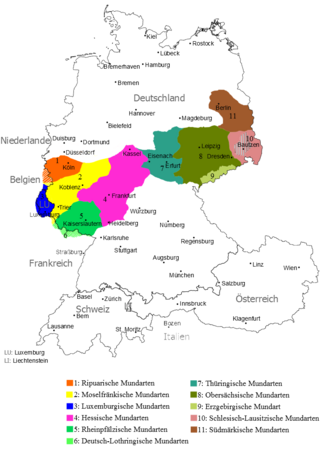
Hessian is a West Central German group of dialects of the German language in the central German state of Hesse. The dialect most similar to Hessian is Palatinate German of the Rhine Franconian sub-family. However, the Hessian dialects have some features which set them somewhat apart from other West-Central German dialects.
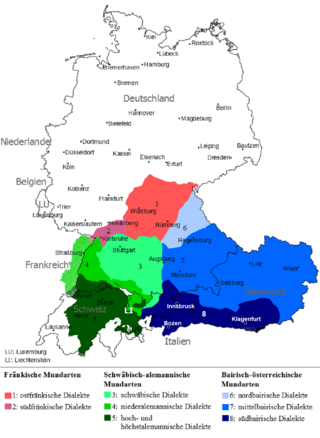
East Franconian or Mainfränkisch, usually referred to as Franconian in German, is a dialect spoken in Franconia, the northern part of the federal state of Bavaria and other areas in Germany around Nuremberg, Bamberg, Coburg, Würzburg, Hof, Bayreuth, Meiningen, Bad Mergentheim, and Crailsheim. The major subgroups are Unterostfränkisch, Oberostfränkisch and Südostfränkisch.

Rhinelandic is a term occasionally used for linguistic varieties of a region on both sides of the Middle and Lower Rhine river in Central West Germany, Belgium, the Netherlands, and Luxembourg, including some varieties of the Limburgish language group, Kleverlandish, Moselle Franconian and Ripuarian. The Local languages of villages or cities are commonly referred to as "the dialects" or "dialect". One of the meanings of Rhinelandic is that of a group of local languages in an area called the Rhineland. Another meaning is that of the regiolect being used by the people approximately of the same area.
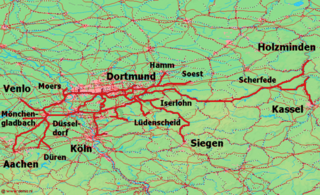
The Bergisch-Markisch Railway Company, also referred to as the Berg-Mark Railway Company or, more rarely, as the Bergisch-Markische Railway Company, was a German railway company that together with the Cologne-Minden Railway and the Rhenish Railway Company was one of the three (nominally) private railway companies that in the mid-19th century built the first railways in the Ruhr and large parts of today's North Rhine-Westphalia. Its name refers to Bergisches Land and the County of Mark.
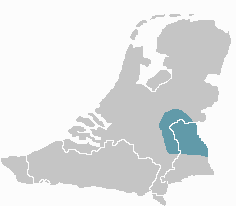
Kleverlandish is a group of Low Franconian dialects spoken on both sides of the Dutch-German border along the Meuse and Rhine rivers.

Remscheid-Lennep station is in the city of Remscheid in the German state of North Rhine-Westphalia. It is the second most important station in the city after Remscheid Hauptbahnhof. The station is located west of the old centre of Lennep and is classified by Deutsche Bahn as a category 5 station.

The Wuppertal-Oberbarmen–Opladen railway was a line built by the Bergisch-Märkische Railway Company in the Bergisches Land of the German state of North Rhine-Westphalia, running from Wuppertal via Remscheid-Lennep, Bergisch Born and Wermelskirchen to Opladen.
Duisburg dialect is the extinct Low Franconian dialect that was spoken in the German city of Duisburg.

Siepen,Siefen,Seifen or Seipen are typical regional words used in northwestern Germany for what are often narrow, wet, ravine-like V-shaped valleys of the German Central Uplands with their small headstreams. In the south German region, such valley forms are usually called Klingen.
The following outline is provided as an overview of and topical guide to German language:
Westkäslausch was a Low Prussian dialect spoken in East Prussia, Germany . It has features of Eastphalian, Westphalian and East Pomeranian dialect.
Eupen dialect is the dialect spoken in the city Eupen.
Southern Low German is a variety of Low German in Germany. Its varieties in Germany are divided into Westphalian and Eastphalian. It borders to Low Franconian, High German and Northern Low German. The Low German varieties of Germany excluding Eastphalian and Westphalian are Northern Low German.
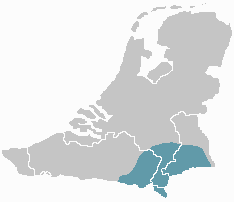
South Low Franconian is a dialect group of the continental West Germanic dialect continuum. South Low Franconian varieties are spoken in Belgium, Germany and the Netherlands and are commonly referred to as "Limburgish" in Belgium and the Netherlands. Its varieties have been traditionally considered dialects of Dutch in the Low Countries and dialects of German in Germany, nevertheless they form a distinct dialect group. In the Netherlands, Limburgish has gained recognition as a regional language.
